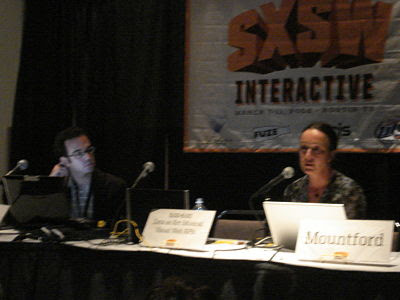Peter Kirn cdm: Create Digital Media
Joy Mountford VP Design Innovation, joymountford.com
Jon and Theresa here at the Data As Art panel, in an extremely packed room and a British-accented panelist. Her name is Joy Mountford and she’s the vice president of Design Innovation. Peter Kirn of Create Digital Media is with her. We are going to write this in real time, just for fun…
Theresa: I like her point that many people search better using visual representations or images. She is showing her development of a web archive of over 250,000 images digitized from 18th century books. It’s pretty amazing. Each photo is alphabetized and then in chronological order. Now she is moving to image software that captures live traffic feeds…
Jon: They are currently showing a video that shows how they use this animation to view traffic and activity on a computer animation. It really makes things like the flow and interchange of activities (e.g. flights) become real and they are more able to analyze the data. They are now showing an animation of the entire globe with these same flight paths. Back to Theresa…
Theresa: We are going to Q&A for Joy! A longer-haired man is asking about the end goal for turning data into these types of images. Joy thinks that it depends on how much money is put forth to this type of initiative. She doesn’t think that the U.S. puts enough importance into the arts which doesn’t make it a priority in the web world either. She is aiming to bridge the gap between a lack of understanding of data and viewing it in an easier format. (Plug for processing.org.)
Jon: Now Mr. Kirn is talking about how people can make these kinds of animations by downloading the program out of processing.org. He is saying that it works through text commands and codes. By using key words like “width” and “height” and “elipse,” you immediately see a circle. Instead of writing lines and lines of code, you can get an immediate result to what you’re doing! Typically, you will try to be as minimal as possible – most of it is not fancy or intricate. Though this may be old news to real programmers, this makes it extremely easy to bypass the tedious steps programmers have to take. This way, whenever you want to add videos, pictures, and even 3-D, you just go to the Internet and find it.
Theresa: Okay, this looks really cool, but it’s hard to explain. He is moving a bit above our technical expertise here. He did just make a whole bunch of images from Flickr fly around in an interface. Now he is playing a music file of his Spam folder. It is actually sounds put to his email inbox that illustrate how often one hits his Inbox. (Laughs from the crowd.)
Jon: Basically, it looks like what we can get out of this panel is that by using programming, we can join together technology with visual images and music. This ability to join the creative with the mechanical really encompasses most of what we see throughout this whole interactive section of the SXSW festival. We are constantly seeing how people that would normally “engineer” these technologies are now finding ways to incorporate art.
PEACE OUT!
Jon and Treese

